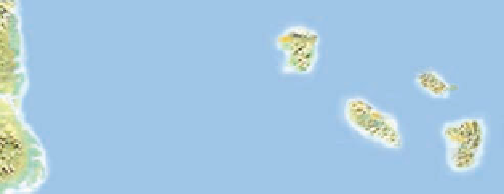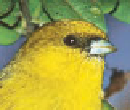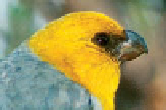Geology Reference
In-Depth Information
eventually brings about the origin of a new species, a phe-
nomenon called
phyletic gradualism
. Another view, known
as
punctuated equilibrium
, holds that little or no change
takes place in a species during most of its existence, and then
evolution occurs rapidly, giving rise to a new species in per-
haps as little as a few thousands of years.
Proponents of punctuated equilibrium argue that few
examples of gradual transitions from one species to another
are found in the fossil record. Critics, however, point out
that neither Darwin nor those who formulated the modern
synthesis insisted that all evolutionary change was gradual
and continuous, a view shared by many present-day biolo-
gists and paleontologists. Furthermore, deposition of sedi-
ments in most environments is not continuous; thus, the
lack of gradual transitions in many cases is simply an arti-
fact of the fossil record. And fi nally, despite the incomplete
nature of the fossil record, a number of examples of gradual
transitions from ancestral to descendant species are well
known.
If speciation occurs as we have described, evidence of it
taking place now should be available, and in fact, it is. For
example, some new plant species have arisen by
polyploidy
when their chromosome count doubled. Speciation, or at
least the fi rst steps in speciation, has taken place and contin-
ues in populations of mosquitoes, bees, mice, salamanders,
fi sh, and birds that are isolated or partly isolated from one
another (Figure 18.7).
◗
Figure 18.7
Allopatric Speciation An example of allopatric
speciation on some remote islands.
1
1
a
(a)
A few individuals of a
species on the mainland
reach isolated island 1.
Speciation follows genetic
divergence in a new habitat.
3
3
2
2
4
4
(b)
Later in time, a few
individuals of the new
species colonize nearby
island 2. In this new
habitat, speciation follows
genetic divergence.
b
1
1
3
3
2
2
4
4
c
(c)
Speciation may also
follow colonization of
islands 3 and 4. And it
may follow invasion of
island 1 by genetically
different descendants
of the ancestral species.
1
1
3
3
2
2
4
4
Divergent evolution
is the phenomenon of an ancestral spe-
cies giving rise to diverse descendant species. An impressive
example involves the mammals whose diversifi cation from
a common ancestor during the Late Mesozoic gave rise to
such varied animals as platypuses, armadillos, rodents, bats,
primates, whales, and rhinoceroses (
The shared ancestor of all
of Hawaii's honeycreepers
probably looked like this
housefinch
(Carpodacus)
Figure 18.8).
Divergent evolution leads to descendants that differ
markedly from their ancestors.
Convergent evolution
and
par-
allel evolution
are processes whereby similar adaptations arise
in different groups. Unfortunately, they differ in degree and
are not always easy to distinguish.
Convergent evolution
in-
volves the development of similar characteristics in distantly
related organisms, whereas similar characteristics arising in
closely related organisms is
parallel evolution
. In both cases,
similar characteristics develop independently because the
organisms in question adapt to comparable environments.
Perhaps the following examples will clarify the distinction
between these two concepts.
During much of the Cenozoic, South America was
an island continent with a unique fauna of mammals that
evolved in isolation. Nevertheless, several mammals in
South and North America adapted in similar ways so that
they superfi cially resembled one another (
◗
Akepa (
Loxous
coccineus
)
Akekee
(
L. caeruleirostris
)
Nihoa finch
(
Telespyza ultima
)
Palila
(
Loxioides bailleui
)
Maiu parrotbill
(
Pseudonestor
xanthrophrys
)
Alauahio
(
Paroreomyza
montana
)
Kauai Amakihi
(
Hemignathus
kauaiensis
)
Akiapolaau
(
H. munroi
)
Akohekohe
(
Palmeria doli
)
Apap
(
Himatione sanguinea
)
Iiwi
(
Vestiaria coccinea
)
Figure 18.9a)—
a good example of convergent evolution. Likewise, conver-
gence also accounts for the superfi cial similarities between
Australian marsupial (pouched) mammals and placental
◗
More than 20 species of Hawaiian honeycreepers have evolved
from a common ancestor as they adapted to diverse resources
on the islands.
d






























Search WWH ::

Custom Search